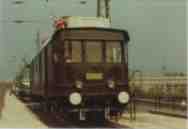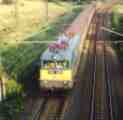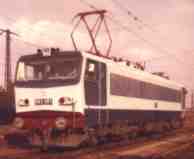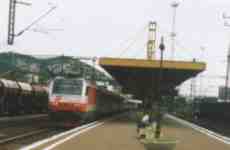History of the electric locomotives in Hungary
by Imre Jákli
The first time in Europe in 1901 on the Valtellina line of the Societa Italiana
delle Strade Ferrate, Meridionali Escerente la Rete Adriatica the idea of
electric railway traction is realised, using the system of a Hungarian
engineer: Kandó Kálmán. This line was electrified using
3000V three-phase 16 2/3 Hz system. A 900hp electric engine pulled the trains,
with a maximum speed of 30km/h. The locomotive has Bo+Bo truck arrangement.
After these prototype engines in 1904 the Italian rail company bought 3
modified locomotives. These locos had 1-C-1 wheel arrangement, 1200hp
continuous power and 62km/h allowed speed. These locomotives had rod drive,
patented by Kandó.
In 1910's the Hungarian State Railways planned to electrify the following
lines with the three-phase system: Cameral-Moravica-Fiume,
Galánta-Zsolna, Salgótarján-Ruttka and the
Pisk-Petrozsény. At the end in 1913 the electrification has
started on the Pisk-Petrozsény and
Ôrváralja-Petrozsény lines for test purposes.
The events of the first world has stopped the works. Meanwhile on the
Vác-Budapest-Gödöllô local railway line (51km long
network) electrified by Siemens, using one-phase 12kV 16 2/3Hz system.
They had 4 electric locomotive and 11 coaches.
A few years later in 1920 the Paris-Orleans Rail Company purchased two
locomotives. These locomotives equipped with two 1500V D.C. engines,
4000hp continuous power. The wheel arrangement was 2-B-B-2 with a maximum
allowed speed of 130km/h. The wheel diameter was 1750mm, which was connected
by a rod. This engine was not so successful, that the Italian ones,
but French liked it and named it as a "Beautiful Hungarian".
 After the first world war in 1922 the Hungarian State Railways decided to
study the possibilities of the electrification of the main lines.
Kandó has started experiments with the one-phase 50Hz system
(This was very interesting experiment, because the 50Hz industrial standard
system was used). They developed a "phase-converter" locomotive (1921),
and used it on the Budapest Nyugati-Dunakeszi-Alag rail line since
September 1923. After the successful tests in 1931 MÁV decided
the electrification of the Budapest-Hegyeshalom line (which nowadays
is the most important), using the 16kV, 50Hz "phase-converter" locomotives.
The phase-converter transformed the high voltage one-phase A.C. current
to 1000V three-phase A.C. current, this was a 16kV one-phase syncron
motor connected to a syncron generator, which fed a triple-phase motor.
After the first world war in 1922 the Hungarian State Railways decided to
study the possibilities of the electrification of the main lines.
Kandó has started experiments with the one-phase 50Hz system
(This was very interesting experiment, because the 50Hz industrial standard
system was used). They developed a "phase-converter" locomotive (1921),
and used it on the Budapest Nyugati-Dunakeszi-Alag rail line since
September 1923. After the successful tests in 1931 MÁV decided
the electrification of the Budapest-Hegyeshalom line (which nowadays
is the most important), using the 16kV, 50Hz "phase-converter" locomotives.
The phase-converter transformed the high voltage one-phase A.C. current
to 1000V three-phase A.C. current, this was a 16kV one-phase syncron
motor connected to a syncron generator, which fed a triple-phase motor.
 The locomotives had 4 syncron speeds, according to the pole number of the
asyncron engine: 25, 50, 75 and 100km/h. These engines could do regenerative
braking! The wheel arrangement was 1-D-1. On the MÁV lines 39 pieces
of the V40 class locomotives was in service. For heavy freight trains
MÁV purchased a modified version. The V60 class locomotives had F
wheel arrangement and 68.3km/h maximal speed. In 1935 Verebély
László made a proposal of the further electrifications.
He suggested to electrify the
Rákos-Hatvan, Kôbánya-alsó-Cegléd
and Bp. Déli-Székesfehérvár lines.
The locomotives had 4 syncron speeds, according to the pole number of the
asyncron engine: 25, 50, 75 and 100km/h. These engines could do regenerative
braking! The wheel arrangement was 1-D-1. On the MÁV lines 39 pieces
of the V40 class locomotives was in service. For heavy freight trains
MÁV purchased a modified version. The V60 class locomotives had F
wheel arrangement and 68.3km/h maximal speed. In 1935 Verebély
László made a proposal of the further electrifications.
He suggested to electrify the
Rákos-Hatvan, Kôbánya-alsó-Cegléd
and Bp. Déli-Székesfehérvár lines.
The rod transmission did not perform well on high speeds. The Hungarian
engineeers has started to develop a new locomotive. The two prototype
locomotives were equipped with a modified phase-converter. This system
is called Rathovszky type phase- and period-converter,
which was a special engine to make the continuous pole switching for the
traction engines. The locomotives had four 1000hp traction engines, with
Meyfahrt-Secheron transmission. The wheel arrangement was 2'D2', economical
speeds were: 25, 50, 75, 100 and 125km/h. The test runs of the prototype
locomotives (V44 class) didn't finished, because both of them were destroyed
in the second world war.
 After the 2nd world was in the 50's MÁV needed to replace the old
V40 and V60 class locomotives. Ganz developed a 2360kW (3200hp) locomotive
with Bo'-Co' wheel arrangement, maximum speed: 125km/h. This locomotive was
still built with a phase and period-converter, but it was a simplified one,
because during the test runs of V44 it has turned out that the continuous
pole number changing is unnecessary. The five 472kW (640hp hourly power)
nose-suspended traction motors were built into the trucks.
The construction was too complicated and outmoded. That's why MÁV
bought only 12 units of this V55 class engine, between 1950 and 1957.
After the 2nd world was in the 50's MÁV needed to replace the old
V40 and V60 class locomotives. Ganz developed a 2360kW (3200hp) locomotive
with Bo'-Co' wheel arrangement, maximum speed: 125km/h. This locomotive was
still built with a phase and period-converter, but it was a simplified one,
because during the test runs of V44 it has turned out that the continuous
pole number changing is unnecessary. The five 472kW (640hp hourly power)
nose-suspended traction motors were built into the trucks.
The construction was too complicated and outmoded. That's why MÁV
bought only 12 units of this V55 class engine, between 1950 and 1957.
 The problem of a suitable and modern locomotive was not sold. The phase-
and period-change system had a lot of technical problems especially with
the technically capable power and the weight of the locomotive. Hungarian
industry couldn't provide an up to date locomotive with electric rectifier.
The momentary solution was a Ward-Leonard type locomotive. Between 1958 and
1961 MÁV bought 30 pieces of these V41 class locomotives. The locos
had Bo'-Bo' wheel arrangement, and were capable of 1070kW (1450hp) maximal
power, 80km/h maximal speed. Later small modifications were performed on the
locomotives. The maximal power raised to 1215kW (1650hp). MÁV had 42
pieces of these engines (V42 class). At the first time these locomotives
operated with 16kV, 50Hz current, but later modified for 25kV 50Hz
(see later).
The problem of a suitable and modern locomotive was not sold. The phase-
and period-change system had a lot of technical problems especially with
the technically capable power and the weight of the locomotive. Hungarian
industry couldn't provide an up to date locomotive with electric rectifier.
The momentary solution was a Ward-Leonard type locomotive. Between 1958 and
1961 MÁV bought 30 pieces of these V41 class locomotives. The locos
had Bo'-Bo' wheel arrangement, and were capable of 1070kW (1450hp) maximal
power, 80km/h maximal speed. Later small modifications were performed on the
locomotives. The maximal power raised to 1215kW (1650hp). MÁV had 42
pieces of these engines (V42 class). At the first time these locomotives
operated with 16kV, 50Hz current, but later modified for 25kV 50Hz
(see later).
 Finally in 1961 MÁV decided to buy a modern electric locomotive,
equipped with silicon rectifiers. MÁV comissioned the
"Arbeits-Gemeinschaft für Planung und Durchführung für
50Hz Bahnelektrifizierung" to develop a locomotive, according to the needs
of the Hugarian railways. This co-operative manufactured 7 locomotives
in 1963. These V43 class locomotives are still running (V43 1001-1007).
Parallel to this purchase Ganz-MÁVAG bought the licence of these
locomotives and from 1964 to 1985 these engines were manufactured in Hungary.
The main parameters: 130km/h maximal speed, B'B' wheel arrangement, 2220kW
(3000hp) continuous power. At that time, on the Budapest-Hegyeshalom
line 16kV 50Hz used (the phase- and period-converter engines operated on
this voltage), but the Budapest-Miskolc line was electrified with 25kV 50Hz.
The first V43 locos could pull trains on both lines. In 1972 on the
Budapest-Hegyeshalom line the voltage raised to 25kV. (Now the 25kV 50Hz
system is the standard in Hungary.) The V43 class locomotives constitute
the basis of the electric pulling capacity of the MÁV.
Closely 380 units operated on the electrified lines.
Finally in 1961 MÁV decided to buy a modern electric locomotive,
equipped with silicon rectifiers. MÁV comissioned the
"Arbeits-Gemeinschaft für Planung und Durchführung für
50Hz Bahnelektrifizierung" to develop a locomotive, according to the needs
of the Hugarian railways. This co-operative manufactured 7 locomotives
in 1963. These V43 class locomotives are still running (V43 1001-1007).
Parallel to this purchase Ganz-MÁVAG bought the licence of these
locomotives and from 1964 to 1985 these engines were manufactured in Hungary.
The main parameters: 130km/h maximal speed, B'B' wheel arrangement, 2220kW
(3000hp) continuous power. At that time, on the Budapest-Hegyeshalom
line 16kV 50Hz used (the phase- and period-converter engines operated on
this voltage), but the Budapest-Miskolc line was electrified with 25kV 50Hz.
The first V43 locos could pull trains on both lines. In 1972 on the
Budapest-Hegyeshalom line the voltage raised to 25kV. (Now the 25kV 50Hz
system is the standard in Hungary.) The V43 class locomotives constitute
the basis of the electric pulling capacity of the MÁV.
Closely 380 units operated on the electrified lines.
 At the beginning of the '70s, the transport requirement increased rapidly,
and the Hugarian
State Railways needed a more powerful locomotive. In 1971 Ganz has started
to develop a new 3600kW (5000hp) locomotive with thyristor rectifiers.
For testing this new technology (it was new for Hungarian Railways at that
time), the V43 1076 and V42 001 were rebuilt with thyristor rectifiers.
The first two V63 class locomotives has started their service in April 1975.
The allowed speed for V63 001 was 120km/h, for V63 002 was 160km/h.
The wheel arrangement is Co'Co', and the truck construction in based on the
one used for a former diesel electric locomotive (M63 class). After the
prototypes, in 1981 (ONLY!!!) the third Gigant followed the fist two.
The null series (V63 003-007) have similar truck (133km/h transmission),
but the carbody was about 20mm higher and they had Hungarian electronics.
The main series equipped with Krupp truck, but the other parts were not
changed. Most of the V63 class units was manufactured between 1984-1988.
At the beginning of the '70s, the transport requirement increased rapidly,
and the Hugarian
State Railways needed a more powerful locomotive. In 1971 Ganz has started
to develop a new 3600kW (5000hp) locomotive with thyristor rectifiers.
For testing this new technology (it was new for Hungarian Railways at that
time), the V43 1076 and V42 001 were rebuilt with thyristor rectifiers.
The first two V63 class locomotives has started their service in April 1975.
The allowed speed for V63 001 was 120km/h, for V63 002 was 160km/h.
The wheel arrangement is Co'Co', and the truck construction in based on the
one used for a former diesel electric locomotive (M63 class). After the
prototypes, in 1981 (ONLY!!!) the third Gigant followed the fist two.
The null series (V63 003-007) have similar truck (133km/h transmission),
but the carbody was about 20mm higher and they had Hungarian electronics.
The main series equipped with Krupp truck, but the other parts were not
changed. Most of the V63 class units was manufactured between 1984-1988.
 In V63 037-056, the control system based on relays replaced with a full
electonic one (The engine drivers call this control equipment compartment
as "Hi-Fi tower"). The total number built for MÁV was 56.
Since 1991 a big recession can be observed in rail transport in Hungary.
These powerful electric locomotives are no longer needed for heavy freight
trains. 11 units of them were regeared for 160km/h maximum allowed speed
(V63 1xx), besides some minor modifications. This transformation was also
an "emergency" solution. The EC and IC service needed fast locomotives.
MÁV didn't have enough money to buy new models. They used the
currently available ones: THE GIGANTs.
The construction of the driving doesn't capable of 160km/h for a long period,
since the traction motors are suspended from the axle that they drive, but
with the minimal financial allocation this was the best solution. These
locomotives are now not as good as they were for freight trains and because
of the large weight of the locomotive (118t) it represents a large "ballast
weight" for passenger trains.
Beside all of these problems GIGANT IS THE MOST POWERFUL LOCOMOTIVE IN
HUNGARY AND THE FAVOURITE OF THE GIGANT CLUB. (Come to Hungary and try
it! ;-) ) Another sad news, that the V63 001-003 were withdrawn on 16th
February 1996 (but it is an another story).
In V63 037-056, the control system based on relays replaced with a full
electonic one (The engine drivers call this control equipment compartment
as "Hi-Fi tower"). The total number built for MÁV was 56.
Since 1991 a big recession can be observed in rail transport in Hungary.
These powerful electric locomotives are no longer needed for heavy freight
trains. 11 units of them were regeared for 160km/h maximum allowed speed
(V63 1xx), besides some minor modifications. This transformation was also
an "emergency" solution. The EC and IC service needed fast locomotives.
MÁV didn't have enough money to buy new models. They used the
currently available ones: THE GIGANTs.
The construction of the driving doesn't capable of 160km/h for a long period,
since the traction motors are suspended from the axle that they drive, but
with the minimal financial allocation this was the best solution. These
locomotives are now not as good as they were for freight trains and because
of the large weight of the locomotive (118t) it represents a large "ballast
weight" for passenger trains.
Beside all of these problems GIGANT IS THE MOST POWERFUL LOCOMOTIVE IN
HUNGARY AND THE FAVOURITE OF THE GIGANT CLUB. (Come to Hungary and try
it! ;-) ) Another sad news, that the V63 001-003 were withdrawn on 16th
February 1996 (but it is an another story).
 In 1983 other development took place at Ganz. For the shunting tasks
MÁV purchased a new 890kW electric engine with thyristor rectifiers
(V46 class). This was far more successful than Gigants, since no modification
performed on the construction of the prototypes and the main series.
These engines has Bo'Bo' wheel arrangement and the maximum allowed speed
is 80km/h of these units.
In 1983 other development took place at Ganz. For the shunting tasks
MÁV purchased a new 890kW electric engine with thyristor rectifiers
(V46 class). This was far more successful than Gigants, since no modification
performed on the construction of the prototypes and the main series.
These engines has Bo'Bo' wheel arrangement and the maximum allowed speed
is 80km/h of these units.
 Beside these shunters, an EMU has started to service in 1991 (BDVmot class).
This has approx. 1200kW power, but it is equipped with asyncron traction
motors. Recently (1995) a new EMU (BVmot class, 1650kW A.C. motors, 160km/h
speed) developed for InterCity service. MÁV bought 3 of them, and
they are now on the Budapest-Szeged line. In the spring of 1996 an EMU trainset,
similar to the BDVmot class (BVh class), purchased from Ganz-Hunslet.
This EMU has similar electronics to the BVmot class but the maximum speed
is only 120km/h. By this time only the two prototype units are in service.
Beside these shunters, an EMU has started to service in 1991 (BDVmot class).
This has approx. 1200kW power, but it is equipped with asyncron traction
motors. Recently (1995) a new EMU (BVmot class, 1650kW A.C. motors, 160km/h
speed) developed for InterCity service. MÁV bought 3 of them, and
they are now on the Budapest-Szeged line. In the spring of 1996 an EMU trainset,
similar to the BDVmot class (BVh class), purchased from Ganz-Hunslet.
This EMU has similar electronics to the BVmot class but the maximum speed
is only 120km/h. By this time only the two prototype units are in service.
 THE FUTURE? It is uncertain. Today the maximum allowed speed is 120km/h
on the MÁV lines, but the Budapest-Hegyeshalom line is preparad for
160km/h service speed. Perhaps from spring 1997 on the part of this line
the maximum allowed speed will be increased for EC, IC and international
trains to 140km/h. For the previously mentioned reasons the V63 1xx
locomotives won't go with 160km/h, only with 140km/h (perhaps in the future).
For EC trains the ÖBB 1014 class engines come to Hungary from Austria,
and they will be able to pull trains with 140km/h. I don't know whether
MÁV decided to buy BVmot units or other type locomotives for high
speed service and instead of the V43 class locomotives. (The oldest ones
are 31 years old, but the newest is now passed 8 years age.) Sooner or
later it should do it!
THE FUTURE? It is uncertain. Today the maximum allowed speed is 120km/h
on the MÁV lines, but the Budapest-Hegyeshalom line is preparad for
160km/h service speed. Perhaps from spring 1997 on the part of this line
the maximum allowed speed will be increased for EC, IC and international
trains to 140km/h. For the previously mentioned reasons the V63 1xx
locomotives won't go with 160km/h, only with 140km/h (perhaps in the future).
For EC trains the ÖBB 1014 class engines come to Hungary from Austria,
and they will be able to pull trains with 140km/h. I don't know whether
MÁV decided to buy BVmot units or other type locomotives for high
speed service and instead of the V43 class locomotives. (The oldest ones
are 31 years old, but the newest is now passed 8 years age.) Sooner or
later it should do it!


 If you have some questions, problems, suggestions or additions,
please contact the V63 Gigant Club.
If you have some questions, problems, suggestions or additions,
please contact the V63 Gigant Club.
Last update: Mon Apr 14 1997
 After the first world war in 1922 the Hungarian State Railways decided to
study the possibilities of the electrification of the main lines.
Kandó has started experiments with the one-phase 50Hz system
(This was very interesting experiment, because the 50Hz industrial standard
system was used). They developed a "phase-converter" locomotive (1921),
and used it on the Budapest Nyugati-Dunakeszi-Alag rail line since
September 1923. After the successful tests in 1931 MÁV decided
the electrification of the Budapest-Hegyeshalom line (which nowadays
is the most important), using the 16kV, 50Hz "phase-converter" locomotives.
The phase-converter transformed the high voltage one-phase A.C. current
to 1000V three-phase A.C. current, this was a 16kV one-phase syncron
motor connected to a syncron generator, which fed a triple-phase motor.
After the first world war in 1922 the Hungarian State Railways decided to
study the possibilities of the electrification of the main lines.
Kandó has started experiments with the one-phase 50Hz system
(This was very interesting experiment, because the 50Hz industrial standard
system was used). They developed a "phase-converter" locomotive (1921),
and used it on the Budapest Nyugati-Dunakeszi-Alag rail line since
September 1923. After the successful tests in 1931 MÁV decided
the electrification of the Budapest-Hegyeshalom line (which nowadays
is the most important), using the 16kV, 50Hz "phase-converter" locomotives.
The phase-converter transformed the high voltage one-phase A.C. current
to 1000V three-phase A.C. current, this was a 16kV one-phase syncron
motor connected to a syncron generator, which fed a triple-phase motor.
 The locomotives had 4 syncron speeds, according to the pole number of the
asyncron engine: 25, 50, 75 and 100km/h. These engines could do regenerative
braking! The wheel arrangement was 1-D-1. On the MÁV lines 39 pieces
of the V40 class locomotives was in service. For heavy freight trains
MÁV purchased a modified version. The V60 class locomotives had F
wheel arrangement and 68.3km/h maximal speed. In 1935 Verebély
László made a proposal of the further electrifications.
He suggested to electrify the
Rákos-Hatvan, Kôbánya-alsó-Cegléd
and Bp. Déli-Székesfehérvár lines.
The locomotives had 4 syncron speeds, according to the pole number of the
asyncron engine: 25, 50, 75 and 100km/h. These engines could do regenerative
braking! The wheel arrangement was 1-D-1. On the MÁV lines 39 pieces
of the V40 class locomotives was in service. For heavy freight trains
MÁV purchased a modified version. The V60 class locomotives had F
wheel arrangement and 68.3km/h maximal speed. In 1935 Verebély
László made a proposal of the further electrifications.
He suggested to electrify the
Rákos-Hatvan, Kôbánya-alsó-Cegléd
and Bp. Déli-Székesfehérvár lines.







